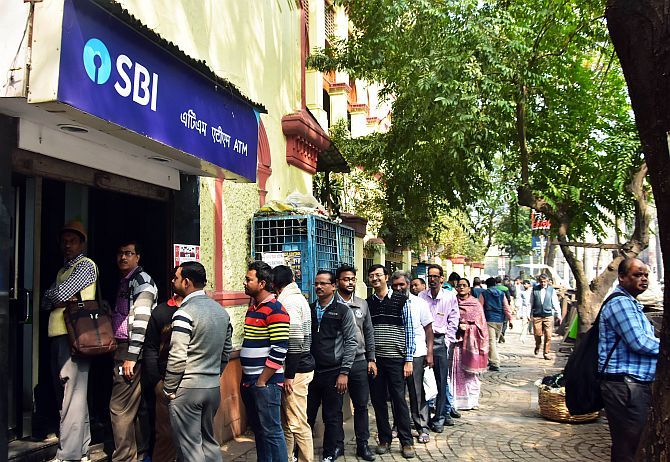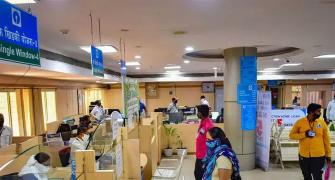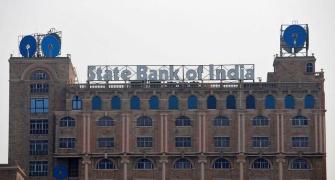'67 per cent of our transactions happen digitally and about 93 per cent of transactions happen outside the branch.'
'Despite that, there is ample scope for promoting banking-related activities in branches.'
'So, for some time, we will have to, probably, live with the same structure.'

The second COVID-19 wave has hit both individuals and businesses hard.
Within three weeks of starting COVID-19 personal loans, State Bank of India, the country's largest lender, has disbursed about Rs 400 crore (rs 4 billion), says its Chairman Dinesh Khara in an interview to Abhijit Lele.
While the June quarter was weak, Khara is betting on retail loan growth on the back of the improving economy.
However, there is very little traction in corporate loans. He also believes the aberration in inflation will go as supply chains normalise.
How was business in Q1 FY22? What was the impact of the second wave on business?
May and June were a little bad. There was some difficulty in collection because the cash flow was disrupted, especially for small and medium enterprises.
That was a matter of concern. Fortunately, the Reserve Bank of India has come up with restructuring guidelines and advances up to Rs 50 crore are eligible for restructuring, and, to my mind, this will provide the required support to the SME sector.
In the second half of June, economic activity started recovering and it may be attributed to the states where unlocking has happened completely.
As we move forward, the increase in vaccination will help in restoring the confidence of the people, which will go a long way in reviving the economy.
How much credit growth did SBI see in Q1? What is the traction in Covid loan books?
The early numbers indicate that we have seen traction in the retail books. But, not much traction was seen in the corporate books.
We came up with three products: One for augmenting the oxygen capacity of hospitals and related infrastructure (Sanjeevani), the second for creating a health-related ecosystem (Arogya), and the third a personal loan to individuals impacted by Covid.
Under the personal loan product (Kavach), we have disbursed Rs 350-400 crore and it started just two-three weeks back.
As far as Arogya is concerned, we have seen some traction.
The share price of SBI and its two listed subsidiaries has risen sharply. Is the market now recognising their true value? And, are you now looking to list the general insurance and mutual fund arms in FY22?
It is quite encouraging to see the response we have got from the market.
Despite that, the valuations (of our subsidiaries) can be better.
The target price that some of the brokerages are indicating is encouraging.
As long as we are in a position to create value for our stakeholders, we will earn the confidence of our investors.
The basic principle SBI follows is, the balance sheet has to remain strong.
We have nurtured these subsidiaries and are in a position to support them in terms of their distribution capabilities.
They also help to enhance fee-based income for SBI. When they attain a certain size that is when we think of listing the subsidiaries.
The general insurance arm is about 10 years old.
It is shaping up well, but we are trying to create some growth levers by strengthening its digital capability.
In some time, we will look to list this subsidiary.
In the case of the mutual fund arm, we have got a joint venture partner (Amundi).
So, we have to ensure that they are aligned to our thought process when it comes to listing.
We are engaging with them and once we come to a stage where both of us agree on the timing and the size of the issuance, then we will make plans public.
What is your take on deposit rates, given that inflation has soared and systemic liquidity remains high?

The deposit rates will be guided by the RBI's policy rates.
Also, equally important will be growth in the economy.
The RBI is focused on growth. If growth remains the focus, there is a limitation when it comes to increasing the borrowing rates.
In this situation, our ability to increase the deposit rate will be restricted.
The current inflation rate that we are seeing is attributed to the supply-side constraints; supply chains are not balanced.
With the unlocking happening, the supply chains will get balanced and this kind of aberration in inflation will probably go.
Again it will give rise to a situation where the RBI will be in a position to support growth.
This kind of trajectory is likely to continue for some time.
As of now, we are comfortably placed on the liquidity front, and all geared up to support the growth of the economy.
What is the update on the restructuring of loans the bank has done so far?
We have reached out to customers asking whether they need any support.
Whoever has indicated that they need restructuring, we are looking into it with a pragmatic approach.
Because, for the greater part of June, the cash flows of SMEs were disrupted.
When customers reach out for restructuring, part of it also involves their perception of the likely time needed for the revival of cash flows.
The bank is gathering data on restructuring requests.
There is frustration with lenders taking steep haircuts in many cases resolved under bankruptcy law. Why have things shaped this way?
The National Company Law Tribunal's effort is to resolve stressed assets.
So, there is a need for a supportive ecosystem.
This also means there should be demand for brownfield capacity.
If at all there has been demand for brownfield capacity, the NCLT has been in a position to ensure a decent amount of realisation.
So, it is a function of the demand for the brownfield capacity and the supply which is available.
More than the process, it is a market-related function.
Therefore, it is also dependent on the overall scenario of the economy.
The deals will depend on the value ascribed to the assets by the market.
Has the time come to take a second look at the bank's structure in a fundamental way?
When it comes to our structure and the kind of variety we handle, both in terms of geography and customer type, we have to have a physical presence and physical touchpoints.
Our situation is such that we have 67 per cent of our transactions happening digitally and about 93 per cent of the transactions happen outside the branch.
Despite that, there is ample scope for promoting banking-related activities in branches.
So, for some time, we will have to, probably, live with the same structure.
Having said that, we have a fairly lean structure.
In many respects, depending on the nature of the business, we have centralised decision-making and branches are like marketing and sales outfits.
We have been tweaking the structure with the passage of time, depending on the business needs and the realities.
SBI has a substantial presence in overseas markets where economic recovery is strong. What contribution do you see from the business?
Last year, the developed world had hardly seen any growth so naturally there was a compression in the balance sheet.
But, this year, we are seeing good traction as the economies are doing much better.
So, hopefully, in the current year, we will get to see a much better response from our international geographies and we should be in a position to see decent growth in our international balance sheet.










